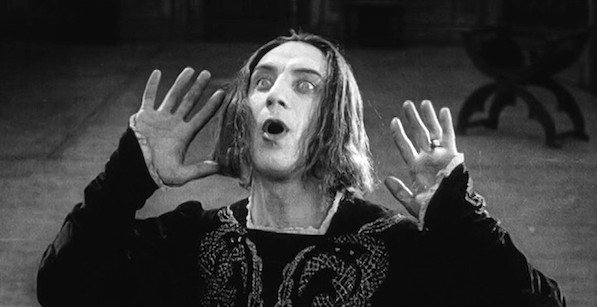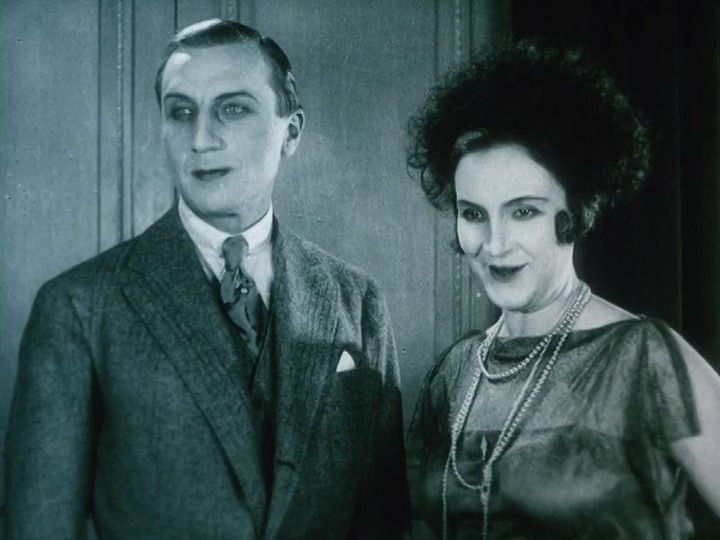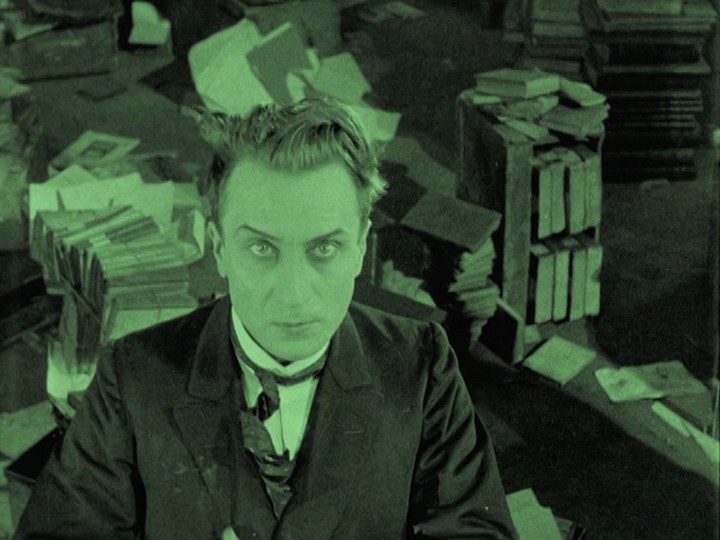An international star of the silent era, Ivan Mosjoukine may not be very well-known today, but there are some good reasons why. One: the Russian Revolution prevented his becoming a long-term icon of Russian cinema; Two: he turned down the lead role in what would have been his most famous film, Abel Gance’s Napoleon. Three: Hollywood did come calling, but their relationship didn’t work out. Four: a heavy accent hobbled his hitherto flourishing European career when Talkies arrived. And five: he died young, succumbing to tuberculosis in 1939.
As for Mosjoukine the filmmaker, there’s a simple reason for his obscurity. While the Russian emigre acted in many movies, he only directed one. But yowsa, what a one. Renoir, considered by many the greatest of all French directors, purportedly called 1923’s The Burning Crucible the first good French film he ever saw. It’s a fabulously eccentric sendup of both faddish modernity—at a moment when Western urban life seemed to be evolving at breakneck speed—as well as fantastical screen adventures like the then-recent French serials Judex and Les Vampires. Mosjoukine’s then-wife and usual costar, Nathalie Lissenko, plays a Paris socialite known simply as Elle. To the dismay of her staid older husband (Nicolas Koline), a wealthy industrialist, she spends all lounging around their manse, fancifully mechanized conveniences satisfying her every whim. On the rare occasions she rouses herself, it’s to pursue some fashionable diversion not very proper for a bazillionaire’s consort. Concerned he’s losing her, the hubby goes to a crazy automated detective agency in this memorably bizarre scene:
There he ends up hiring none other than the famous private eye Zed (Mosjoukine), in whom the wife finally meets her match. Eventually a romantic triangle develops, as Zed is torn between duty to his highly respectable paying client and the knowledge that he’s probably a far more suitable mate for adventurous, ultra-modern Elle.
For such an inherently frivolous mix of comedy, romance and light social critique, The Burning Crucible is often wildly ambitious—throwing in extravagantly stylized dream sequences and surrealist ideas. While gaining some admiration at the time for those offbeat aspects, Mosjoukine’s free imagination caused the film to go well over-budget, and it was simply too unusual to be embraced sufficiently by the ticket-buying public that had already made him a matinee idol. His acting career continued apace, but no one was urging him to get behind the camera again.
To understand how he might have been given carte blanche as a first-time director, you’d need to grasp the cultural juggernaut Ivan Mosjoukine had become. His original rise had been rapid: Leaving law school to pursue an acting career in 1910, he transitioned quickly from stage work to a screen debut the following year. Soon he was the leading star of a pre-Revolutionary Russian cinema has been overshadowed by the early Soviet “golden era” since, but was quite prodigious and sophisticated at the time. He excelled at demanding classical roles taken from Dostoevsky, Pushkin and Tolstoy.
But when Tsarist rule was overthrown in 1918, he purportedly faced execution as a relic of the decadent recent past, fleeing westward with numerous artistic collaborators including Lissenko and his frequent directors Alexandre Volkoff and Viktor Tourjansky. Ironically, the single thing for which he may be best remembered today was something created in his absence, without his consent: Soviet filmmaker Lev Kuleshov used images from Mosjoukine’s now-banned earlier vehicles to illustrate the theory of montage known as the Kuleshov Effect, in which viewer perception of an actor’s unchanging expression shifts as influenced by the disparate shots it’s intercut with.
His films having already been exported for some years, the actor didn’t find it difficult to re-establish himself in Europe. He settled in France and rose to even greater prominence as a dashing, versatile player in both costume dramas and modern escapist fare (like seven-hour adventure serial The House of Mystery, released just before The Burning Crucible). Considered an “exotic” type, he brought great emotional intensity and physical bravado to parts of various ethnicity; his most famous role of the Jazz Age, as you-know-who in Volkoff’s saucy 1927 The Loves of Casanova, made such a splash that he repeated it in a talkie seven years later. Another impressive film that survives is the same director’s 1924 Kean, or Wildness and Genius (it’s also known as Edmund Kean: Prince Among Lovers). Portraying the self-destructive early 19th-century British stage actor whom many then thought the greatest actor of all time, Mosjoukine is larger-than-life whether evading creditors, partying large, pursuing umpteen women, or performing Shakespeare to adoring crowds. Here he is, driving ‘em wild with sheer drunken joie de vivre at his favorite lowbrow tavern:
Finding himself rivals with the Prince of Wales over one aristocratic female fan, he addresses that royal with the unfortunate intertitle line “When I see you enter her box, I feel like I’m losing my mind.” While playing Hamlet (of course), Kean does lose his mind, a fast final degeneration leading to one of the most prolonged death scenes in cinema. (Or even opera.)
Another major showcase was The Late Mathias Pascal, a three-hour adaptation of a Luigi Pirandello novel by Marcel L’Herbier, a significant French cultural figure for decades whose most striking and ambitious cinematic work was during the late silent era. This nearly three-hour 1925 feature, one of his greatest popular successes (though the director’s extravagance in this period constantly imperiled his financial stability), stars Mosjoukine as a “tortured dreamer” of a ruined aristocrat whom fate gifts with a chance to abandon his bitter old life for a brand new identity in Rome. Of course the past can’t be escaped quite so easily. But before luck comes full-circle, he enjoys this climax to a streak of good fortune at the roulette wheel, contrasted with the bottoming-out of a patron who’s suffered quite the opposite:
Lavish, lengthy vehicles like these got Mosjoukine termed “the European Valentino” in some quarters, and when the real one died young at the height of his fame in 1926, Hollywood figured him for a ready-made replacement. Mosjoukine & Co. duly schlepped across the Atlantic and the United States. But this sojourn wasn’t a happy one: Universal purportedly insisted he get plastic surgery to modify his magnificent hawk-nosed profile (something he immediately regretted), then made him play second fiddle to Phantom of the Opera ingenue Mary Philbin in the melodrama Surrender. She was cast as an Eastern European maiden whose virtue is demanded by Cossack military leader Mosjoukine in return for his sparing her village from pogrom. It was a hokey venture that did not play to his strengths, and was not particularly successful. Even if it had been, the actor’s stay in California would likely have been brief. It premiered just after the launch of The Jazz Singer, and the “all talking! all singing! all dancing!” craze that film started would prove the undoing of many foreign-born silent stars whose accents sank them in the sound era.
Silence stayed golden in Europe a bit longer than in America, so upon returning there his star remained high in the firmament for a few more years. But by the mid-1930s his career was well past prime, and one suspects a lust for life not unlike many of his flamboyantly romantic characters helped lead to his death at age 49 (or 51, as records of his birthdate vary). Decades later, French novelist Romain Gary attracted some attention by making the claim that he was born as a result of an affair between his actress mother and Mosjoukine (who had left no legitimate heirs). First published in an autobiographical novel, this speculative paternity was further popularized by a stage dramatization, then a 1970 film version (Promise at Dawn) with fifty-something married couple Melina Mercouri and Jules Dassin cast as the youthful alleged lovers.
One suspects Mosjoukine would have enjoyed being the center of attention again, even if the whole story was a fabrication.






